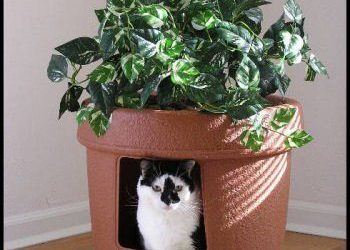Photo by James Yarema on Unsplash
Many people struggle to get their cats into cat carriers. There are several reasons why this happens.
- The carrier may smell funny because it’s new.
- The carrier may carry the energy of fear from past trips or from other cats.
- The carrier may not be the right size for your cat.
- Your cat has not had an opportunity to become acquainted with the carrier as a safe place.
- Your cat never sees the carrier until it’s time to go see the veterinarian, and your cat has unpleasant memories of those trips and visits.
Here are some ways to resolve these issues before they start.
[Note: Small dogs who are unaccustomed to crates may experience the same issues, and can be helped in the same ways – except for the catnip. ]
If the carrier is new, be sure to wash it thoroughly to remove dirt and chemical scents. Most products today are sprayed with formaldehyde as a preservative. The formaldehyde has a “bad” smell, so it’s usually mixed with another scent to cover up the smell. You don’t want your cat inhaling this stuff, so washing the carrier out before you use it is healthier and lessens or eliminates the smell.
If the carrier is not new, it’s a good idea to clean with an unscented enzyme cleaner between uses. This makes it more sanitary, and if you have more than one cat, you will eliminate the smell of the last feline who used it, making it more comfortable for the next cat to use it.
A Voice of Experience
Today there are soft carriers and hard plastic carriers. The soft ones are easier to carry, but can lead to problems if you have a feisty cat who doesn’t like being confined and a carrier that’s not strong enough to stand up to cat claws.
When Starlight was a kitten and taken to be spayed, she was young and energetic. I picked her up the evening of her surgery. She was feeling good and was frustrated with being confined to a cage all day. She was in a brand new soft carrier.
As I drove onto the entry ramp to the Interstate, I placed my right hand next to the front of the carrier on the seat next to me. I wanted to reassure her that all was well because I could hear her scratching at the carrier.
Instead, I was shocked to feel her head pressing up against the palm of my hand. Starlight had torn the carrier open!
This was a definite safety hazard. I quickly found a spot to pull over to evaluate the situation. There was no other option but for me to hold the carrier closed with my right hand and drive left-handed all the way home.
For a long time after that, I only used a hard plastic carrier when Starlight had to travel, but with experience and maturity, she was able to travel in a soft carrier.
Having the Correct Size Carrier.
It’s important to have a carrier that’s the correct size for your cat. A cat who find the carrier too small won’t want to go into it.
The carrier you buy for a small kitten will quickly be outgrown as your kitten matures. On the other hand, a large carrier for a small kitten won’t be safe unless there is lots of soft material inside to prevent the kitten from bouncing around.
To determine the correct size carrier, you want your cat to be able to lie down and stretch it’s legs, especially if the trips are more than 30 minutes. You also want your cat to be able to stand up without hitting it’s head on the top of the carrier. The cat should also be able to go into the carrier and turn around easily.
Measure your cat’s height from top of shoulders to the floor. Then measure your cat’s length from tip of nose to base of tail. These measurements will help you decide what size carrier to get.
IMPORTANT: Carriers in cars must be seat-belted in or immobilized so that it can slip around or fall off the seat. You cat can be frightened and even injured if the carrier slides about or tips over during travel!
Teaching Your Cat to Accept a Cat Carrier
Here are steps you can take to help your cat become accustomed to a cat carrier. Best to do this before an emergency. It will take time and patience and effort on your part to help your cat feel at home in the carrier.
1. Clean a new carrier or one that has been previously used by another cat with an unscented enzyme cleaner and dry it thoroughly before putting anything into it.
2. Set up the carrier on the floor with the entry door open.
3. Make sure the carrier has something soft that smells familiar inside the carrier.
4. Mist the inside of the carrier with 5-Flower Formula by FES (Flower Essence Services).
A cat who is unfamiliar with carriers will be curious and is likely to explore. On the other hand, a cat who has unpleasant memories of trips in carriers may avoid the carrier altogether.
5. Put a food dish next to it and let the cat get used to eating next to the carrier.
6. Put some dried catnip or a treat in the doorway of the carrier to entice the cat to go up to the carrier and eat.
As your cat becomes comfortable in front of the door, slowly move the catnip or treat or food further and further into the carrier. This may take several days or longer, so be patient.
7. Young kittens can be enticed to go into carriers if you roll or toss toys into it while playing with your kitten. This activity is fun for the kitten, who learns that carriers can be comfortable places to play.
The day you find your cat or kitten playing or snoozing inside the carrier is a day to celebrate!
Preparing the Carrier for a Trip
It’s OK to leave a cat carrier lying open on the floor for your cat to enjoy it on a regular basis. However, if your home or apartment doesn’t have enough space to do this, once your cat is comfortable with the carrier, you can put it away.
When planning a visit to the vet, take the carrier back out a few days ahead of time and put it back on the floor. Spray with the Five-Flower Formula. Put something that smells familiar back into the carrier and let your cat reacquaint him/herself with it.
In an emergency, you won’t have time to take all these steps. Therefore, be sure to clean the carrier when you get home after each use.
Emergency Preparation Pays Off
In an emergency, using Five Flower Formula on your cat and spraying it inside the carrier takes just a moment.
If you’ve prepared your cat in the past, you will have eliminated the cat carrier trauma from what may already be a stressful situation.






0 Comments